Auckland International Campus AM807001 Entrepreneurship Report
VerifiedAdded on 2023/04/24
|9
|3111
|470
Report
AI Summary
This report assesses the product innovation of TOHU Wines, a Maori-based wine company, focusing on the development of a kiwi fruit wine. It utilizes the LEAN Canvas to analyze the problem, solution, unique value proposition, unfair advantage, channels, customer segments, key metrics, cost structure, and revenue streams. The report also includes market segmentation and brand positioning, business risk analysis (including target segment risk, sales risk, customer satisfaction, and revenue potential), and the impact of Maori culture on product recommendations. The report suggests that the kiwi fruit wine would be a healthier and environmentally friendly alternative to traditional alcoholic beverages, leveraging TOHU Wines' established brand identity and Maori cultural values to gain market share. It highlights the importance of organic ingredients and eco-friendly packaging, along with emphasizing health benefits in marketing campaigns.
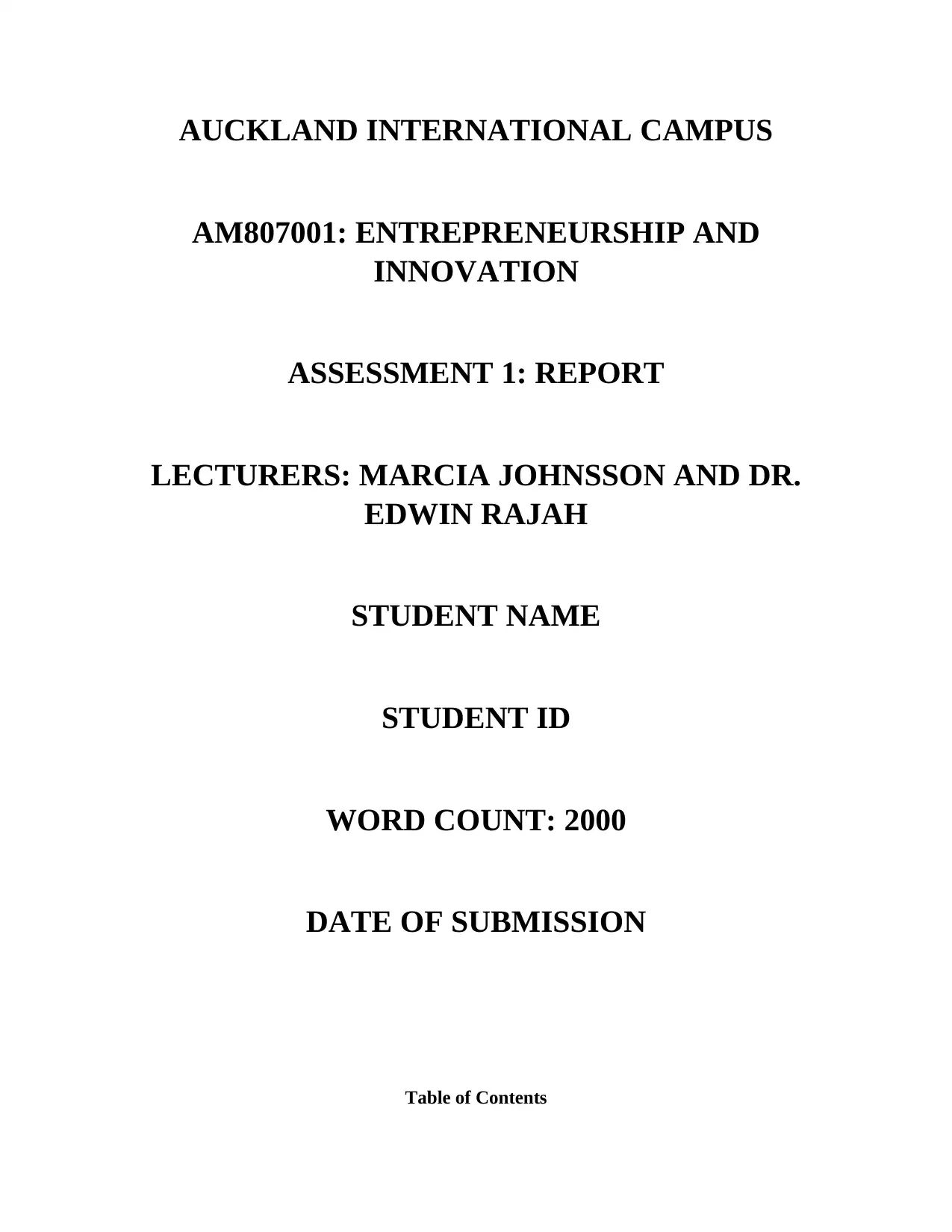
AUCKLAND INTERNATIONAL CAMPUS
AM807001: ENTREPRENEURSHIP AND
INNOVATION
ASSESSMENT 1: REPORT
LECTURERS: MARCIA JOHNSSON AND DR.
EDWIN RAJAH
STUDENT NAME
STUDENT ID
WORD COUNT: 2000
DATE OF SUBMISSION
Table of Contents
AM807001: ENTREPRENEURSHIP AND
INNOVATION
ASSESSMENT 1: REPORT
LECTURERS: MARCIA JOHNSSON AND DR.
EDWIN RAJAH
STUDENT NAME
STUDENT ID
WORD COUNT: 2000
DATE OF SUBMISSION
Table of Contents
Paraphrase This Document
Need a fresh take? Get an instant paraphrase of this document with our AI Paraphraser
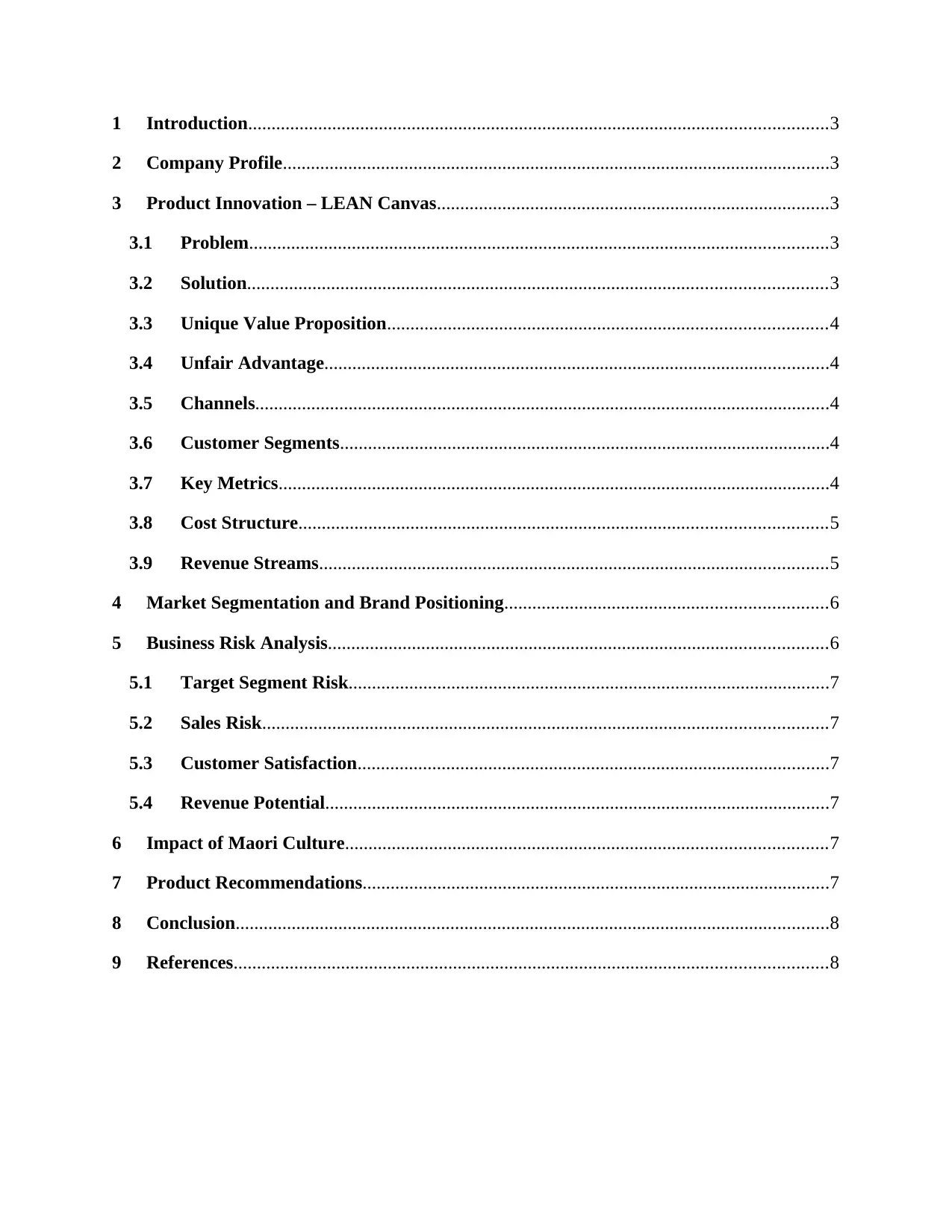
1 Introduction............................................................................................................................3
2 Company Profile.....................................................................................................................3
3 Product Innovation – LEAN Canvas....................................................................................3
3.1 Problem............................................................................................................................3
3.2 Solution............................................................................................................................3
3.3 Unique Value Proposition..............................................................................................4
3.4 Unfair Advantage............................................................................................................4
3.5 Channels...........................................................................................................................4
3.6 Customer Segments.........................................................................................................4
3.7 Key Metrics......................................................................................................................4
3.8 Cost Structure.................................................................................................................5
3.9 Revenue Streams.............................................................................................................5
4 Market Segmentation and Brand Positioning.....................................................................6
5 Business Risk Analysis...........................................................................................................6
5.1 Target Segment Risk.......................................................................................................7
5.2 Sales Risk.........................................................................................................................7
5.3 Customer Satisfaction.....................................................................................................7
5.4 Revenue Potential............................................................................................................7
6 Impact of Maori Culture.......................................................................................................7
7 Product Recommendations....................................................................................................7
8 Conclusion...............................................................................................................................8
9 References...............................................................................................................................8
2 Company Profile.....................................................................................................................3
3 Product Innovation – LEAN Canvas....................................................................................3
3.1 Problem............................................................................................................................3
3.2 Solution............................................................................................................................3
3.3 Unique Value Proposition..............................................................................................4
3.4 Unfair Advantage............................................................................................................4
3.5 Channels...........................................................................................................................4
3.6 Customer Segments.........................................................................................................4
3.7 Key Metrics......................................................................................................................4
3.8 Cost Structure.................................................................................................................5
3.9 Revenue Streams.............................................................................................................5
4 Market Segmentation and Brand Positioning.....................................................................6
5 Business Risk Analysis...........................................................................................................6
5.1 Target Segment Risk.......................................................................................................7
5.2 Sales Risk.........................................................................................................................7
5.3 Customer Satisfaction.....................................................................................................7
5.4 Revenue Potential............................................................................................................7
6 Impact of Maori Culture.......................................................................................................7
7 Product Recommendations....................................................................................................7
8 Conclusion...............................................................................................................................8
9 References...............................................................................................................................8
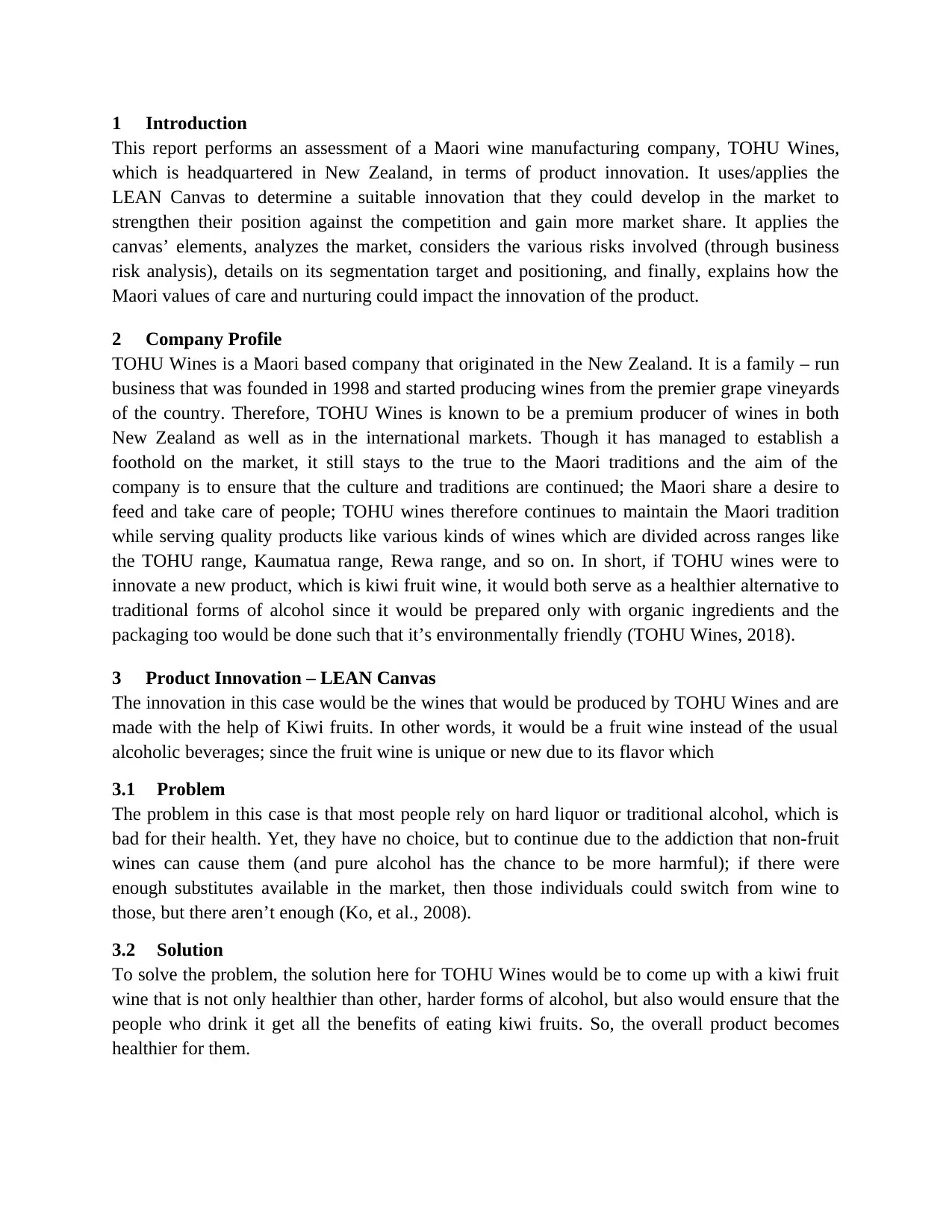
1 Introduction
This report performs an assessment of a Maori wine manufacturing company, TOHU Wines,
which is headquartered in New Zealand, in terms of product innovation. It uses/applies the
LEAN Canvas to determine a suitable innovation that they could develop in the market to
strengthen their position against the competition and gain more market share. It applies the
canvas’ elements, analyzes the market, considers the various risks involved (through business
risk analysis), details on its segmentation target and positioning, and finally, explains how the
Maori values of care and nurturing could impact the innovation of the product.
2 Company Profile
TOHU Wines is a Maori based company that originated in the New Zealand. It is a family – run
business that was founded in 1998 and started producing wines from the premier grape vineyards
of the country. Therefore, TOHU Wines is known to be a premium producer of wines in both
New Zealand as well as in the international markets. Though it has managed to establish a
foothold on the market, it still stays to the true to the Maori traditions and the aim of the
company is to ensure that the culture and traditions are continued; the Maori share a desire to
feed and take care of people; TOHU wines therefore continues to maintain the Maori tradition
while serving quality products like various kinds of wines which are divided across ranges like
the TOHU range, Kaumatua range, Rewa range, and so on. In short, if TOHU wines were to
innovate a new product, which is kiwi fruit wine, it would both serve as a healthier alternative to
traditional forms of alcohol since it would be prepared only with organic ingredients and the
packaging too would be done such that it’s environmentally friendly (TOHU Wines, 2018).
3 Product Innovation – LEAN Canvas
The innovation in this case would be the wines that would be produced by TOHU Wines and are
made with the help of Kiwi fruits. In other words, it would be a fruit wine instead of the usual
alcoholic beverages; since the fruit wine is unique or new due to its flavor which
3.1 Problem
The problem in this case is that most people rely on hard liquor or traditional alcohol, which is
bad for their health. Yet, they have no choice, but to continue due to the addiction that non-fruit
wines can cause them (and pure alcohol has the chance to be more harmful); if there were
enough substitutes available in the market, then those individuals could switch from wine to
those, but there aren’t enough (Ko, et al., 2008).
3.2 Solution
To solve the problem, the solution here for TOHU Wines would be to come up with a kiwi fruit
wine that is not only healthier than other, harder forms of alcohol, but also would ensure that the
people who drink it get all the benefits of eating kiwi fruits. So, the overall product becomes
healthier for them.
This report performs an assessment of a Maori wine manufacturing company, TOHU Wines,
which is headquartered in New Zealand, in terms of product innovation. It uses/applies the
LEAN Canvas to determine a suitable innovation that they could develop in the market to
strengthen their position against the competition and gain more market share. It applies the
canvas’ elements, analyzes the market, considers the various risks involved (through business
risk analysis), details on its segmentation target and positioning, and finally, explains how the
Maori values of care and nurturing could impact the innovation of the product.
2 Company Profile
TOHU Wines is a Maori based company that originated in the New Zealand. It is a family – run
business that was founded in 1998 and started producing wines from the premier grape vineyards
of the country. Therefore, TOHU Wines is known to be a premium producer of wines in both
New Zealand as well as in the international markets. Though it has managed to establish a
foothold on the market, it still stays to the true to the Maori traditions and the aim of the
company is to ensure that the culture and traditions are continued; the Maori share a desire to
feed and take care of people; TOHU wines therefore continues to maintain the Maori tradition
while serving quality products like various kinds of wines which are divided across ranges like
the TOHU range, Kaumatua range, Rewa range, and so on. In short, if TOHU wines were to
innovate a new product, which is kiwi fruit wine, it would both serve as a healthier alternative to
traditional forms of alcohol since it would be prepared only with organic ingredients and the
packaging too would be done such that it’s environmentally friendly (TOHU Wines, 2018).
3 Product Innovation – LEAN Canvas
The innovation in this case would be the wines that would be produced by TOHU Wines and are
made with the help of Kiwi fruits. In other words, it would be a fruit wine instead of the usual
alcoholic beverages; since the fruit wine is unique or new due to its flavor which
3.1 Problem
The problem in this case is that most people rely on hard liquor or traditional alcohol, which is
bad for their health. Yet, they have no choice, but to continue due to the addiction that non-fruit
wines can cause them (and pure alcohol has the chance to be more harmful); if there were
enough substitutes available in the market, then those individuals could switch from wine to
those, but there aren’t enough (Ko, et al., 2008).
3.2 Solution
To solve the problem, the solution here for TOHU Wines would be to come up with a kiwi fruit
wine that is not only healthier than other, harder forms of alcohol, but also would ensure that the
people who drink it get all the benefits of eating kiwi fruits. So, the overall product becomes
healthier for them.
⊘ This is a preview!⊘
Do you want full access?
Subscribe today to unlock all pages.

Trusted by 1+ million students worldwide
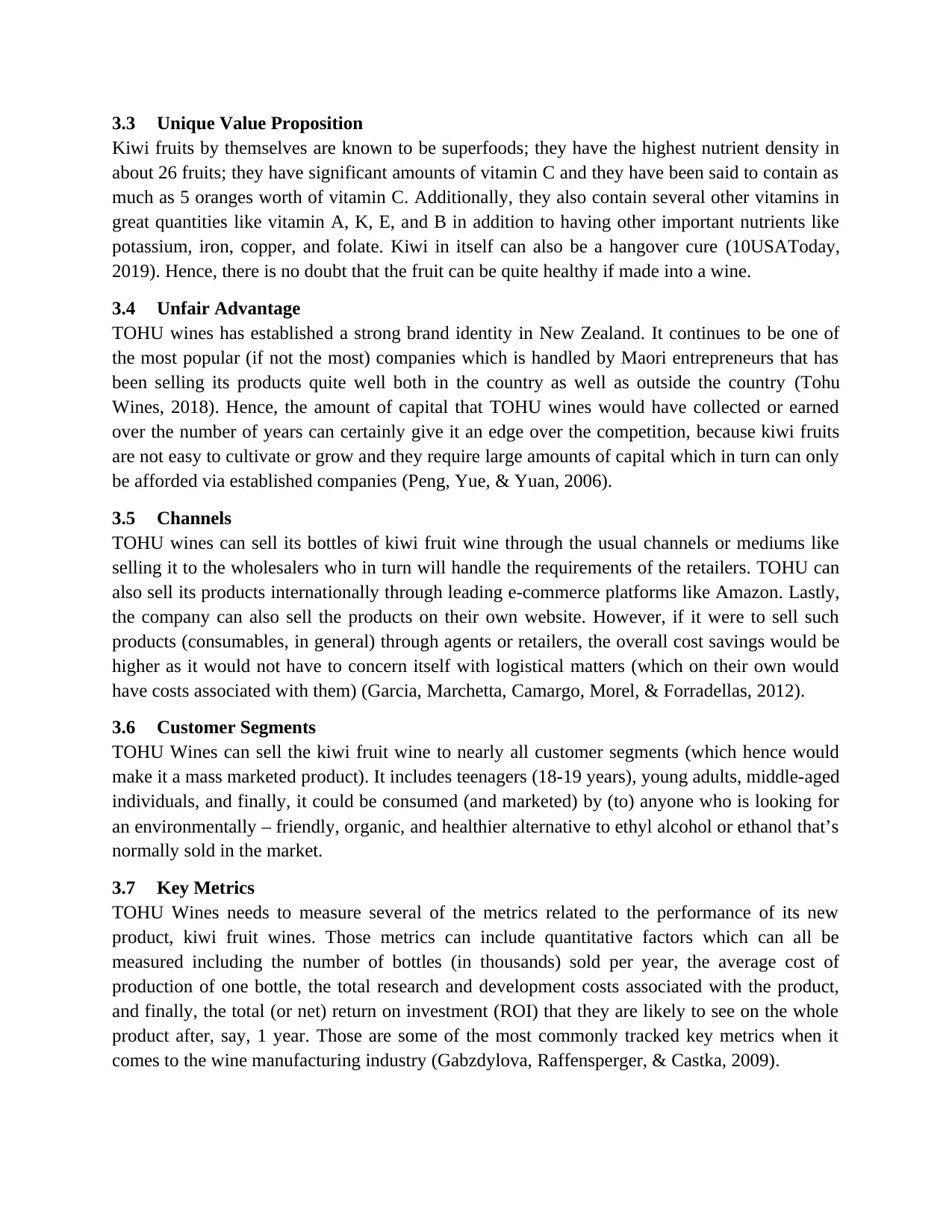
3.3 Unique Value Proposition
Kiwi fruits by themselves are known to be superfoods; they have the highest nutrient density in
about 26 fruits; they have significant amounts of vitamin C and they have been said to contain as
much as 5 oranges worth of vitamin C. Additionally, they also contain several other vitamins in
great quantities like vitamin A, K, E, and B in addition to having other important nutrients like
potassium, iron, copper, and folate. Kiwi in itself can also be a hangover cure (10USAToday,
2019). Hence, there is no doubt that the fruit can be quite healthy if made into a wine.
3.4 Unfair Advantage
TOHU wines has established a strong brand identity in New Zealand. It continues to be one of
the most popular (if not the most) companies which is handled by Maori entrepreneurs that has
been selling its products quite well both in the country as well as outside the country (Tohu
Wines, 2018). Hence, the amount of capital that TOHU wines would have collected or earned
over the number of years can certainly give it an edge over the competition, because kiwi fruits
are not easy to cultivate or grow and they require large amounts of capital which in turn can only
be afforded via established companies (Peng, Yue, & Yuan, 2006).
3.5 Channels
TOHU wines can sell its bottles of kiwi fruit wine through the usual channels or mediums like
selling it to the wholesalers who in turn will handle the requirements of the retailers. TOHU can
also sell its products internationally through leading e-commerce platforms like Amazon. Lastly,
the company can also sell the products on their own website. However, if it were to sell such
products (consumables, in general) through agents or retailers, the overall cost savings would be
higher as it would not have to concern itself with logistical matters (which on their own would
have costs associated with them) (Garcia, Marchetta, Camargo, Morel, & Forradellas, 2012).
3.6 Customer Segments
TOHU Wines can sell the kiwi fruit wine to nearly all customer segments (which hence would
make it a mass marketed product). It includes teenagers (18-19 years), young adults, middle-aged
individuals, and finally, it could be consumed (and marketed) by (to) anyone who is looking for
an environmentally – friendly, organic, and healthier alternative to ethyl alcohol or ethanol that’s
normally sold in the market.
3.7 Key Metrics
TOHU Wines needs to measure several of the metrics related to the performance of its new
product, kiwi fruit wines. Those metrics can include quantitative factors which can all be
measured including the number of bottles (in thousands) sold per year, the average cost of
production of one bottle, the total research and development costs associated with the product,
and finally, the total (or net) return on investment (ROI) that they are likely to see on the whole
product after, say, 1 year. Those are some of the most commonly tracked key metrics when it
comes to the wine manufacturing industry (Gabzdylova, Raffensperger, & Castka, 2009).
Kiwi fruits by themselves are known to be superfoods; they have the highest nutrient density in
about 26 fruits; they have significant amounts of vitamin C and they have been said to contain as
much as 5 oranges worth of vitamin C. Additionally, they also contain several other vitamins in
great quantities like vitamin A, K, E, and B in addition to having other important nutrients like
potassium, iron, copper, and folate. Kiwi in itself can also be a hangover cure (10USAToday,
2019). Hence, there is no doubt that the fruit can be quite healthy if made into a wine.
3.4 Unfair Advantage
TOHU wines has established a strong brand identity in New Zealand. It continues to be one of
the most popular (if not the most) companies which is handled by Maori entrepreneurs that has
been selling its products quite well both in the country as well as outside the country (Tohu
Wines, 2018). Hence, the amount of capital that TOHU wines would have collected or earned
over the number of years can certainly give it an edge over the competition, because kiwi fruits
are not easy to cultivate or grow and they require large amounts of capital which in turn can only
be afforded via established companies (Peng, Yue, & Yuan, 2006).
3.5 Channels
TOHU wines can sell its bottles of kiwi fruit wine through the usual channels or mediums like
selling it to the wholesalers who in turn will handle the requirements of the retailers. TOHU can
also sell its products internationally through leading e-commerce platforms like Amazon. Lastly,
the company can also sell the products on their own website. However, if it were to sell such
products (consumables, in general) through agents or retailers, the overall cost savings would be
higher as it would not have to concern itself with logistical matters (which on their own would
have costs associated with them) (Garcia, Marchetta, Camargo, Morel, & Forradellas, 2012).
3.6 Customer Segments
TOHU Wines can sell the kiwi fruit wine to nearly all customer segments (which hence would
make it a mass marketed product). It includes teenagers (18-19 years), young adults, middle-aged
individuals, and finally, it could be consumed (and marketed) by (to) anyone who is looking for
an environmentally – friendly, organic, and healthier alternative to ethyl alcohol or ethanol that’s
normally sold in the market.
3.7 Key Metrics
TOHU Wines needs to measure several of the metrics related to the performance of its new
product, kiwi fruit wines. Those metrics can include quantitative factors which can all be
measured including the number of bottles (in thousands) sold per year, the average cost of
production of one bottle, the total research and development costs associated with the product,
and finally, the total (or net) return on investment (ROI) that they are likely to see on the whole
product after, say, 1 year. Those are some of the most commonly tracked key metrics when it
comes to the wine manufacturing industry (Gabzdylova, Raffensperger, & Castka, 2009).
Paraphrase This Document
Need a fresh take? Get an instant paraphrase of this document with our AI Paraphraser
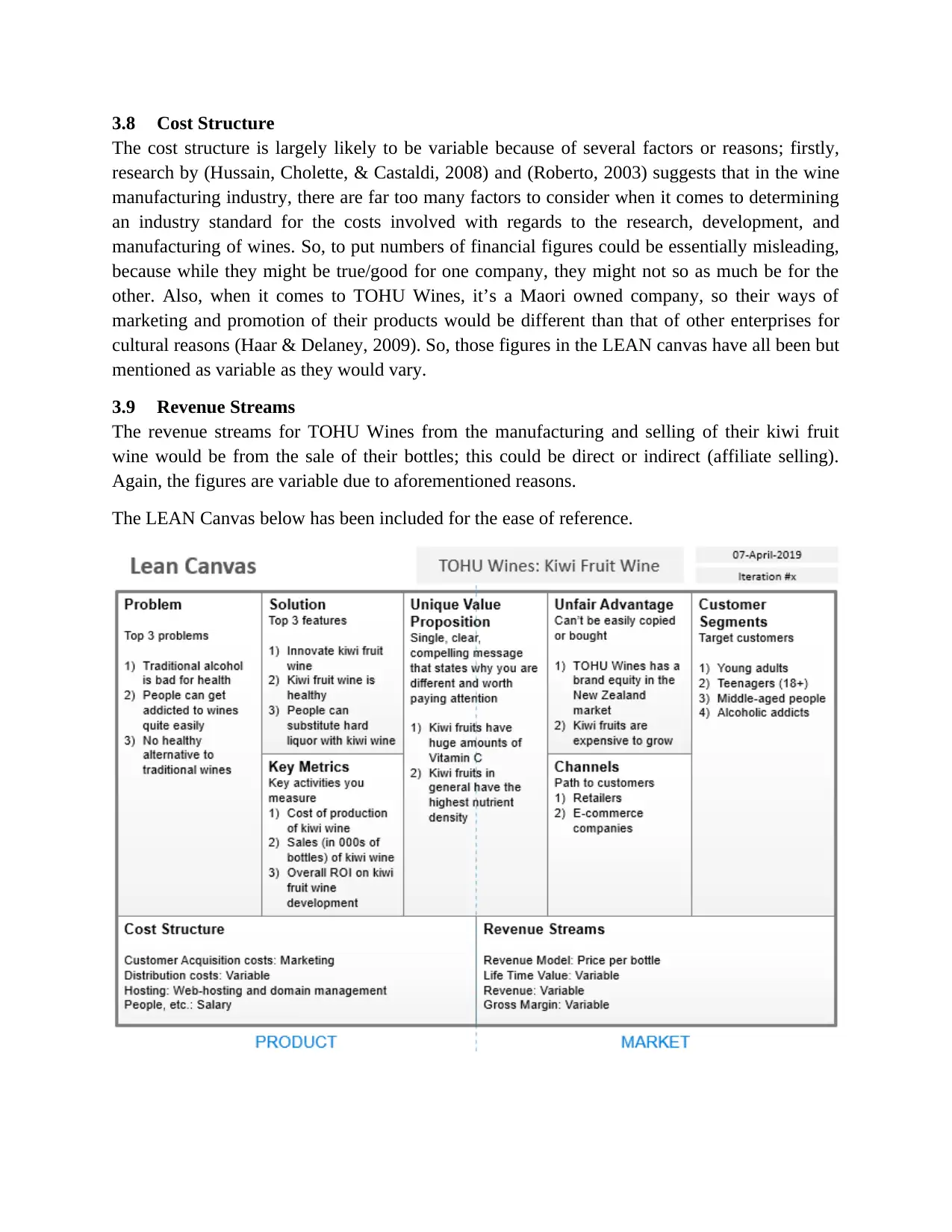
3.8 Cost Structure
The cost structure is largely likely to be variable because of several factors or reasons; firstly,
research by (Hussain, Cholette, & Castaldi, 2008) and (Roberto, 2003) suggests that in the wine
manufacturing industry, there are far too many factors to consider when it comes to determining
an industry standard for the costs involved with regards to the research, development, and
manufacturing of wines. So, to put numbers of financial figures could be essentially misleading,
because while they might be true/good for one company, they might not so as much be for the
other. Also, when it comes to TOHU Wines, it’s a Maori owned company, so their ways of
marketing and promotion of their products would be different than that of other enterprises for
cultural reasons (Haar & Delaney, 2009). So, those figures in the LEAN canvas have all been but
mentioned as variable as they would vary.
3.9 Revenue Streams
The revenue streams for TOHU Wines from the manufacturing and selling of their kiwi fruit
wine would be from the sale of their bottles; this could be direct or indirect (affiliate selling).
Again, the figures are variable due to aforementioned reasons.
The LEAN Canvas below has been included for the ease of reference.
The cost structure is largely likely to be variable because of several factors or reasons; firstly,
research by (Hussain, Cholette, & Castaldi, 2008) and (Roberto, 2003) suggests that in the wine
manufacturing industry, there are far too many factors to consider when it comes to determining
an industry standard for the costs involved with regards to the research, development, and
manufacturing of wines. So, to put numbers of financial figures could be essentially misleading,
because while they might be true/good for one company, they might not so as much be for the
other. Also, when it comes to TOHU Wines, it’s a Maori owned company, so their ways of
marketing and promotion of their products would be different than that of other enterprises for
cultural reasons (Haar & Delaney, 2009). So, those figures in the LEAN canvas have all been but
mentioned as variable as they would vary.
3.9 Revenue Streams
The revenue streams for TOHU Wines from the manufacturing and selling of their kiwi fruit
wine would be from the sale of their bottles; this could be direct or indirect (affiliate selling).
Again, the figures are variable due to aforementioned reasons.
The LEAN Canvas below has been included for the ease of reference.
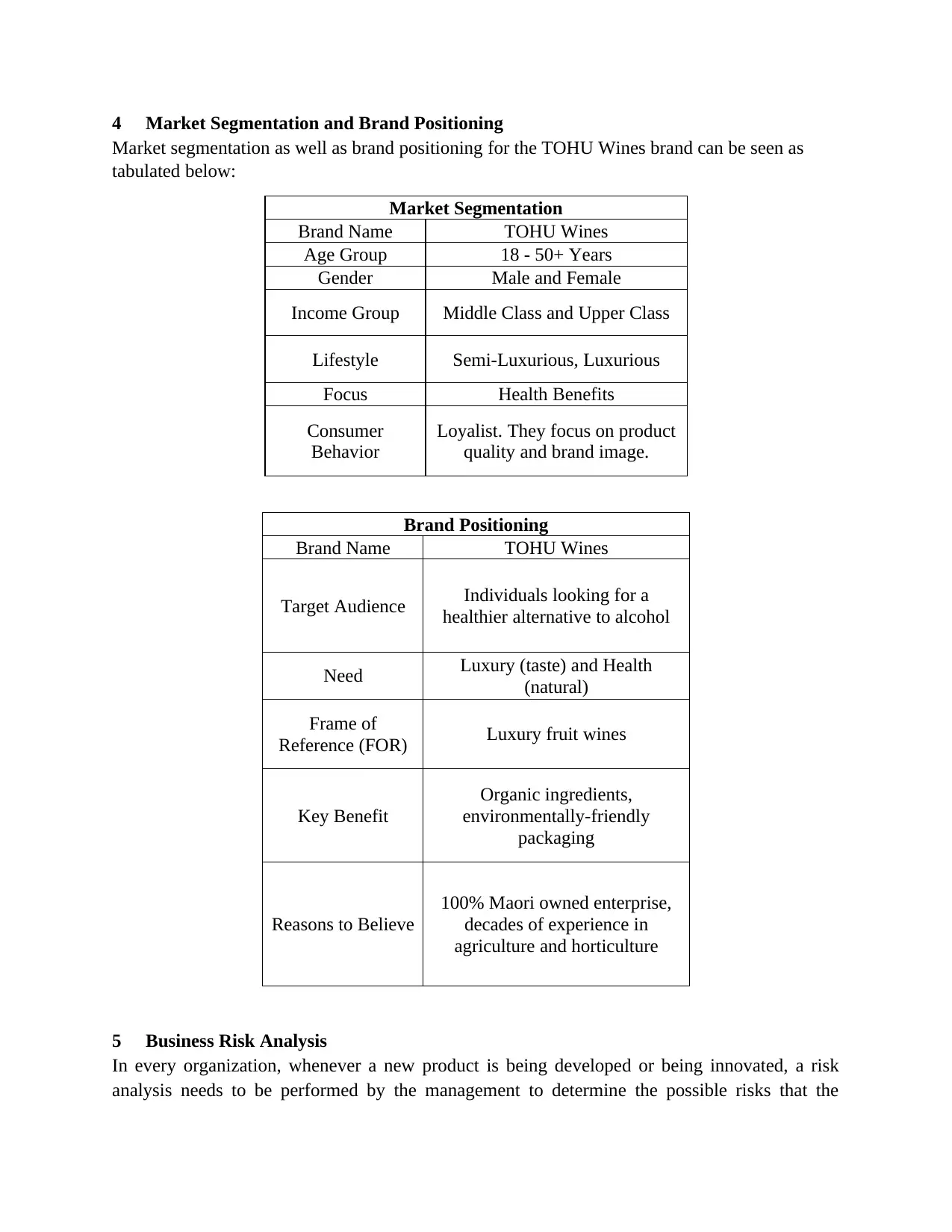
4 Market Segmentation and Brand Positioning
Market segmentation as well as brand positioning for the TOHU Wines brand can be seen as
tabulated below:
Market Segmentation
Brand Name TOHU Wines
Age Group 18 - 50+ Years
Gender Male and Female
Income Group Middle Class and Upper Class
Lifestyle Semi-Luxurious, Luxurious
Focus Health Benefits
Consumer
Behavior
Loyalist. They focus on product
quality and brand image.
Brand Positioning
Brand Name TOHU Wines
Target Audience Individuals looking for a
healthier alternative to alcohol
Need Luxury (taste) and Health
(natural)
Frame of
Reference (FOR) Luxury fruit wines
Key Benefit
Organic ingredients,
environmentally-friendly
packaging
Reasons to Believe
100% Maori owned enterprise,
decades of experience in
agriculture and horticulture
5 Business Risk Analysis
In every organization, whenever a new product is being developed or being innovated, a risk
analysis needs to be performed by the management to determine the possible risks that the
Market segmentation as well as brand positioning for the TOHU Wines brand can be seen as
tabulated below:
Market Segmentation
Brand Name TOHU Wines
Age Group 18 - 50+ Years
Gender Male and Female
Income Group Middle Class and Upper Class
Lifestyle Semi-Luxurious, Luxurious
Focus Health Benefits
Consumer
Behavior
Loyalist. They focus on product
quality and brand image.
Brand Positioning
Brand Name TOHU Wines
Target Audience Individuals looking for a
healthier alternative to alcohol
Need Luxury (taste) and Health
(natural)
Frame of
Reference (FOR) Luxury fruit wines
Key Benefit
Organic ingredients,
environmentally-friendly
packaging
Reasons to Believe
100% Maori owned enterprise,
decades of experience in
agriculture and horticulture
5 Business Risk Analysis
In every organization, whenever a new product is being developed or being innovated, a risk
analysis needs to be performed by the management to determine the possible risks that the
⊘ This is a preview!⊘
Do you want full access?
Subscribe today to unlock all pages.

Trusted by 1+ million students worldwide
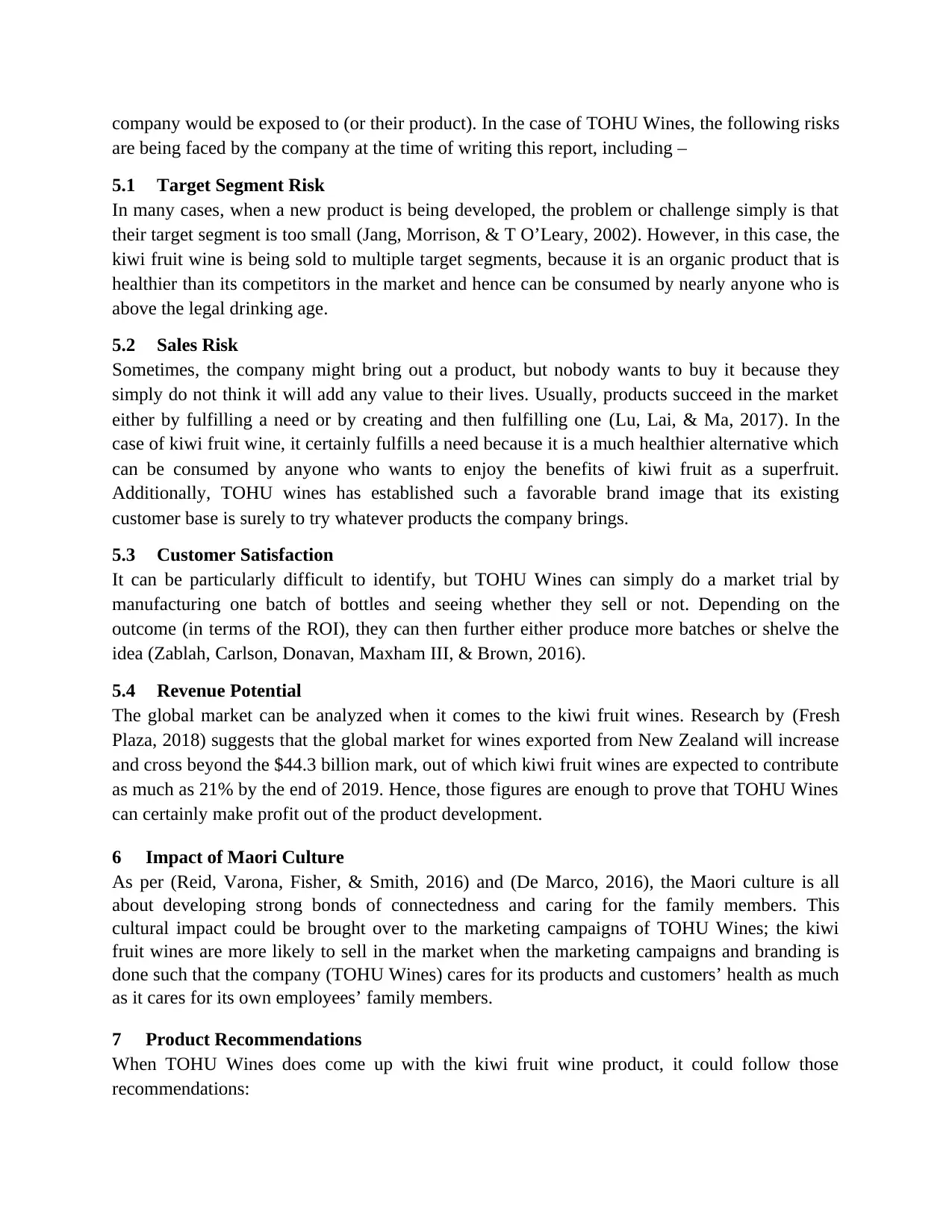
company would be exposed to (or their product). In the case of TOHU Wines, the following risks
are being faced by the company at the time of writing this report, including –
5.1 Target Segment Risk
In many cases, when a new product is being developed, the problem or challenge simply is that
their target segment is too small (Jang, Morrison, & T O’Leary, 2002). However, in this case, the
kiwi fruit wine is being sold to multiple target segments, because it is an organic product that is
healthier than its competitors in the market and hence can be consumed by nearly anyone who is
above the legal drinking age.
5.2 Sales Risk
Sometimes, the company might bring out a product, but nobody wants to buy it because they
simply do not think it will add any value to their lives. Usually, products succeed in the market
either by fulfilling a need or by creating and then fulfilling one (Lu, Lai, & Ma, 2017). In the
case of kiwi fruit wine, it certainly fulfills a need because it is a much healthier alternative which
can be consumed by anyone who wants to enjoy the benefits of kiwi fruit as a superfruit.
Additionally, TOHU wines has established such a favorable brand image that its existing
customer base is surely to try whatever products the company brings.
5.3 Customer Satisfaction
It can be particularly difficult to identify, but TOHU Wines can simply do a market trial by
manufacturing one batch of bottles and seeing whether they sell or not. Depending on the
outcome (in terms of the ROI), they can then further either produce more batches or shelve the
idea (Zablah, Carlson, Donavan, Maxham III, & Brown, 2016).
5.4 Revenue Potential
The global market can be analyzed when it comes to the kiwi fruit wines. Research by (Fresh
Plaza, 2018) suggests that the global market for wines exported from New Zealand will increase
and cross beyond the $44.3 billion mark, out of which kiwi fruit wines are expected to contribute
as much as 21% by the end of 2019. Hence, those figures are enough to prove that TOHU Wines
can certainly make profit out of the product development.
6 Impact of Maori Culture
As per (Reid, Varona, Fisher, & Smith, 2016) and (De Marco, 2016), the Maori culture is all
about developing strong bonds of connectedness and caring for the family members. This
cultural impact could be brought over to the marketing campaigns of TOHU Wines; the kiwi
fruit wines are more likely to sell in the market when the marketing campaigns and branding is
done such that the company (TOHU Wines) cares for its products and customers’ health as much
as it cares for its own employees’ family members.
7 Product Recommendations
When TOHU Wines does come up with the kiwi fruit wine product, it could follow those
recommendations:
are being faced by the company at the time of writing this report, including –
5.1 Target Segment Risk
In many cases, when a new product is being developed, the problem or challenge simply is that
their target segment is too small (Jang, Morrison, & T O’Leary, 2002). However, in this case, the
kiwi fruit wine is being sold to multiple target segments, because it is an organic product that is
healthier than its competitors in the market and hence can be consumed by nearly anyone who is
above the legal drinking age.
5.2 Sales Risk
Sometimes, the company might bring out a product, but nobody wants to buy it because they
simply do not think it will add any value to their lives. Usually, products succeed in the market
either by fulfilling a need or by creating and then fulfilling one (Lu, Lai, & Ma, 2017). In the
case of kiwi fruit wine, it certainly fulfills a need because it is a much healthier alternative which
can be consumed by anyone who wants to enjoy the benefits of kiwi fruit as a superfruit.
Additionally, TOHU wines has established such a favorable brand image that its existing
customer base is surely to try whatever products the company brings.
5.3 Customer Satisfaction
It can be particularly difficult to identify, but TOHU Wines can simply do a market trial by
manufacturing one batch of bottles and seeing whether they sell or not. Depending on the
outcome (in terms of the ROI), they can then further either produce more batches or shelve the
idea (Zablah, Carlson, Donavan, Maxham III, & Brown, 2016).
5.4 Revenue Potential
The global market can be analyzed when it comes to the kiwi fruit wines. Research by (Fresh
Plaza, 2018) suggests that the global market for wines exported from New Zealand will increase
and cross beyond the $44.3 billion mark, out of which kiwi fruit wines are expected to contribute
as much as 21% by the end of 2019. Hence, those figures are enough to prove that TOHU Wines
can certainly make profit out of the product development.
6 Impact of Maori Culture
As per (Reid, Varona, Fisher, & Smith, 2016) and (De Marco, 2016), the Maori culture is all
about developing strong bonds of connectedness and caring for the family members. This
cultural impact could be brought over to the marketing campaigns of TOHU Wines; the kiwi
fruit wines are more likely to sell in the market when the marketing campaigns and branding is
done such that the company (TOHU Wines) cares for its products and customers’ health as much
as it cares for its own employees’ family members.
7 Product Recommendations
When TOHU Wines does come up with the kiwi fruit wine product, it could follow those
recommendations:
Paraphrase This Document
Need a fresh take? Get an instant paraphrase of this document with our AI Paraphraser
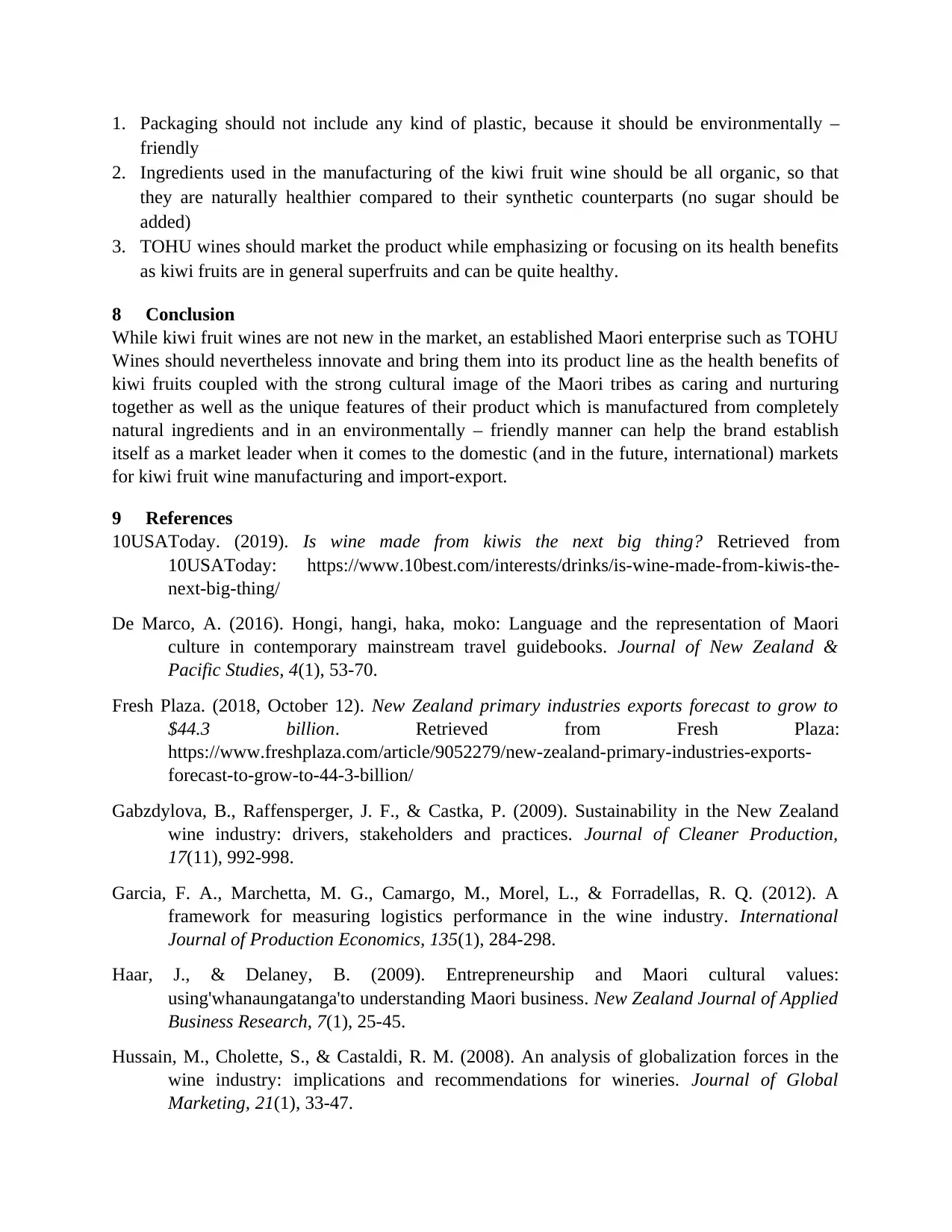
1. Packaging should not include any kind of plastic, because it should be environmentally –
friendly
2. Ingredients used in the manufacturing of the kiwi fruit wine should be all organic, so that
they are naturally healthier compared to their synthetic counterparts (no sugar should be
added)
3. TOHU wines should market the product while emphasizing or focusing on its health benefits
as kiwi fruits are in general superfruits and can be quite healthy.
8 Conclusion
While kiwi fruit wines are not new in the market, an established Maori enterprise such as TOHU
Wines should nevertheless innovate and bring them into its product line as the health benefits of
kiwi fruits coupled with the strong cultural image of the Maori tribes as caring and nurturing
together as well as the unique features of their product which is manufactured from completely
natural ingredients and in an environmentally – friendly manner can help the brand establish
itself as a market leader when it comes to the domestic (and in the future, international) markets
for kiwi fruit wine manufacturing and import-export.
9 References
10USAToday. (2019). Is wine made from kiwis the next big thing? Retrieved from
10USAToday: https://www.10best.com/interests/drinks/is-wine-made-from-kiwis-the-
next-big-thing/
De Marco, A. (2016). Hongi, hangi, haka, moko: Language and the representation of Maori
culture in contemporary mainstream travel guidebooks. Journal of New Zealand &
Pacific Studies, 4(1), 53-70.
Fresh Plaza. (2018, October 12). New Zealand primary industries exports forecast to grow to
$44.3 billion. Retrieved from Fresh Plaza:
https://www.freshplaza.com/article/9052279/new-zealand-primary-industries-exports-
forecast-to-grow-to-44-3-billion/
Gabzdylova, B., Raffensperger, J. F., & Castka, P. (2009). Sustainability in the New Zealand
wine industry: drivers, stakeholders and practices. Journal of Cleaner Production,
17(11), 992-998.
Garcia, F. A., Marchetta, M. G., Camargo, M., Morel, L., & Forradellas, R. Q. (2012). A
framework for measuring logistics performance in the wine industry. International
Journal of Production Economics, 135(1), 284-298.
Haar, J., & Delaney, B. (2009). Entrepreneurship and Maori cultural values:
using'whanaungatanga'to understanding Maori business. New Zealand Journal of Applied
Business Research, 7(1), 25-45.
Hussain, M., Cholette, S., & Castaldi, R. M. (2008). An analysis of globalization forces in the
wine industry: implications and recommendations for wineries. Journal of Global
Marketing, 21(1), 33-47.
friendly
2. Ingredients used in the manufacturing of the kiwi fruit wine should be all organic, so that
they are naturally healthier compared to their synthetic counterparts (no sugar should be
added)
3. TOHU wines should market the product while emphasizing or focusing on its health benefits
as kiwi fruits are in general superfruits and can be quite healthy.
8 Conclusion
While kiwi fruit wines are not new in the market, an established Maori enterprise such as TOHU
Wines should nevertheless innovate and bring them into its product line as the health benefits of
kiwi fruits coupled with the strong cultural image of the Maori tribes as caring and nurturing
together as well as the unique features of their product which is manufactured from completely
natural ingredients and in an environmentally – friendly manner can help the brand establish
itself as a market leader when it comes to the domestic (and in the future, international) markets
for kiwi fruit wine manufacturing and import-export.
9 References
10USAToday. (2019). Is wine made from kiwis the next big thing? Retrieved from
10USAToday: https://www.10best.com/interests/drinks/is-wine-made-from-kiwis-the-
next-big-thing/
De Marco, A. (2016). Hongi, hangi, haka, moko: Language and the representation of Maori
culture in contemporary mainstream travel guidebooks. Journal of New Zealand &
Pacific Studies, 4(1), 53-70.
Fresh Plaza. (2018, October 12). New Zealand primary industries exports forecast to grow to
$44.3 billion. Retrieved from Fresh Plaza:
https://www.freshplaza.com/article/9052279/new-zealand-primary-industries-exports-
forecast-to-grow-to-44-3-billion/
Gabzdylova, B., Raffensperger, J. F., & Castka, P. (2009). Sustainability in the New Zealand
wine industry: drivers, stakeholders and practices. Journal of Cleaner Production,
17(11), 992-998.
Garcia, F. A., Marchetta, M. G., Camargo, M., Morel, L., & Forradellas, R. Q. (2012). A
framework for measuring logistics performance in the wine industry. International
Journal of Production Economics, 135(1), 284-298.
Haar, J., & Delaney, B. (2009). Entrepreneurship and Maori cultural values:
using'whanaungatanga'to understanding Maori business. New Zealand Journal of Applied
Business Research, 7(1), 25-45.
Hussain, M., Cholette, S., & Castaldi, R. M. (2008). An analysis of globalization forces in the
wine industry: implications and recommendations for wineries. Journal of Global
Marketing, 21(1), 33-47.
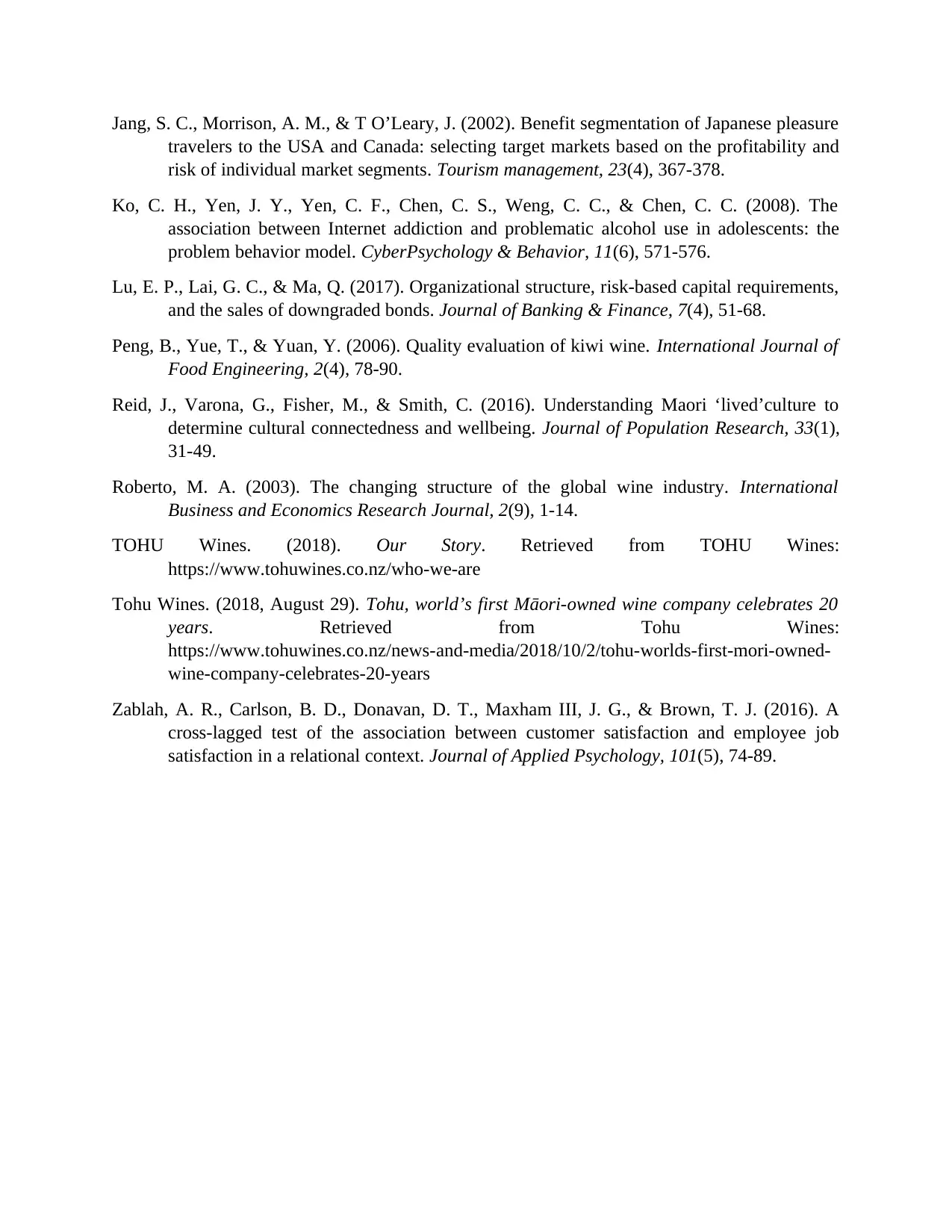
Jang, S. C., Morrison, A. M., & T O’Leary, J. (2002). Benefit segmentation of Japanese pleasure
travelers to the USA and Canada: selecting target markets based on the profitability and
risk of individual market segments. Tourism management, 23(4), 367-378.
Ko, C. H., Yen, J. Y., Yen, C. F., Chen, C. S., Weng, C. C., & Chen, C. C. (2008). The
association between Internet addiction and problematic alcohol use in adolescents: the
problem behavior model. CyberPsychology & Behavior, 11(6), 571-576.
Lu, E. P., Lai, G. C., & Ma, Q. (2017). Organizational structure, risk-based capital requirements,
and the sales of downgraded bonds. Journal of Banking & Finance, 7(4), 51-68.
Peng, B., Yue, T., & Yuan, Y. (2006). Quality evaluation of kiwi wine. International Journal of
Food Engineering, 2(4), 78-90.
Reid, J., Varona, G., Fisher, M., & Smith, C. (2016). Understanding Maori ‘lived’culture to
determine cultural connectedness and wellbeing. Journal of Population Research, 33(1),
31-49.
Roberto, M. A. (2003). The changing structure of the global wine industry. International
Business and Economics Research Journal, 2(9), 1-14.
TOHU Wines. (2018). Our Story. Retrieved from TOHU Wines:
https://www.tohuwines.co.nz/who-we-are
Tohu Wines. (2018, August 29). Tohu, world’s first Māori-owned wine company celebrates 20
years. Retrieved from Tohu Wines:
https://www.tohuwines.co.nz/news-and-media/2018/10/2/tohu-worlds-first-mori-owned-
wine-company-celebrates-20-years
Zablah, A. R., Carlson, B. D., Donavan, D. T., Maxham III, J. G., & Brown, T. J. (2016). A
cross-lagged test of the association between customer satisfaction and employee job
satisfaction in a relational context. Journal of Applied Psychology, 101(5), 74-89.
travelers to the USA and Canada: selecting target markets based on the profitability and
risk of individual market segments. Tourism management, 23(4), 367-378.
Ko, C. H., Yen, J. Y., Yen, C. F., Chen, C. S., Weng, C. C., & Chen, C. C. (2008). The
association between Internet addiction and problematic alcohol use in adolescents: the
problem behavior model. CyberPsychology & Behavior, 11(6), 571-576.
Lu, E. P., Lai, G. C., & Ma, Q. (2017). Organizational structure, risk-based capital requirements,
and the sales of downgraded bonds. Journal of Banking & Finance, 7(4), 51-68.
Peng, B., Yue, T., & Yuan, Y. (2006). Quality evaluation of kiwi wine. International Journal of
Food Engineering, 2(4), 78-90.
Reid, J., Varona, G., Fisher, M., & Smith, C. (2016). Understanding Maori ‘lived’culture to
determine cultural connectedness and wellbeing. Journal of Population Research, 33(1),
31-49.
Roberto, M. A. (2003). The changing structure of the global wine industry. International
Business and Economics Research Journal, 2(9), 1-14.
TOHU Wines. (2018). Our Story. Retrieved from TOHU Wines:
https://www.tohuwines.co.nz/who-we-are
Tohu Wines. (2018, August 29). Tohu, world’s first Māori-owned wine company celebrates 20
years. Retrieved from Tohu Wines:
https://www.tohuwines.co.nz/news-and-media/2018/10/2/tohu-worlds-first-mori-owned-
wine-company-celebrates-20-years
Zablah, A. R., Carlson, B. D., Donavan, D. T., Maxham III, J. G., & Brown, T. J. (2016). A
cross-lagged test of the association between customer satisfaction and employee job
satisfaction in a relational context. Journal of Applied Psychology, 101(5), 74-89.
⊘ This is a preview!⊘
Do you want full access?
Subscribe today to unlock all pages.

Trusted by 1+ million students worldwide
1 out of 9
Related Documents
Your All-in-One AI-Powered Toolkit for Academic Success.
+13062052269
info@desklib.com
Available 24*7 on WhatsApp / Email
![[object Object]](/_next/static/media/star-bottom.7253800d.svg)
Unlock your academic potential
Copyright © 2020–2025 A2Z Services. All Rights Reserved. Developed and managed by ZUCOL.





